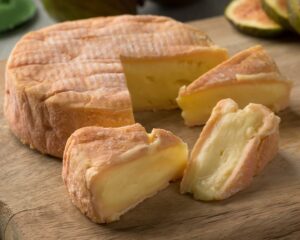
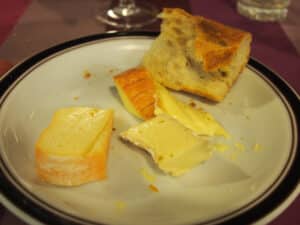
And if we turn up in the morning, we’ll be able to see the cheese being made!
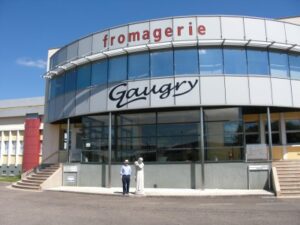
Cheese plays a big part in France’s view of itself. Charles de Gaulle once lamented “No one can bring together a country that has 365 kinds of cheese”. I’ve never been a big fan of de Gaulle, so it comes as no surprise to learn that he couldn’t count very well – the Paris Insider’s Guide suggests there are 1,000 different cheeses in France!
Unlike President de Gaulle, the Paris Insider have ranked their Top 10. You can read about the Cheese Charts in more detail here, but here’s their Top 10:
Paris Insider’s Top 10 French Cheeses
1. Camembert
2. Brie de Meaux
3. Roquefort
4. Reblochon
5. Munster
6. Pont l’Évêque
7. Époisses de Bourgogne
8. Comté
9. Emmenthal
10. Abondance
That’s just wrong, isn’t it? Camembert and Brie in the top 2 places? Obvious nonsense, although I am tempted to explore Brie de Meaux a bit further. Here’s the correct Top 3:
The Official (ie The Chain Gang) Top 3 French Cheeses
1. Époisses
2. Comté
3. Roquefort
Let me tell you a little bit about Époisses.
Firstly, it smells! It really smells – the appellation website calls its aroma ‘penetrating’.
Nearly all (non-goats) cheese is based on coagulating milk using rennet from the stomachs of calves. Not so Époisse! Or nearly not so. Époisse is coagulated using mostly lactic acid (and a little bit of rennet, so it’s still no good for vegetarians).
Cheese is basically a process where specific bacteria are allowed to work on coagulated milk, where the process is controlled and slowed using salt, so that cheese is created and matured, rather than a mouldy mush. The breed of cow or
sheep, the bacteria that are ambient, and the temperature that the milk is heated to, these all determine what type of cheese you get. 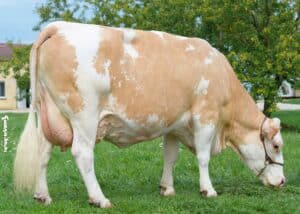
For example, if you take milk from a Vosgienne cow (Alsace), take it to your fromagerie full of Brevibacterium Linens bacteria, and accidentally heat the milk to 44 C instead of 34, you’ll still get cheese – but not Munster. (Regional cheeses from pasteurised milk? I’m glad you asked – heated to 65 degrees, then cooled very quickly to the required temperature.) Likewise, if you get the bacteria right, the milk right and you don’t mess-up the heating, but you don’t wipe the cheese with salt, you won’t get cheese, you’ll just get milk that’s gone-off! You need it all, and it’s the combinations that determine which cheese. Something in the following makes Époisses special – I just don’t know which bit (-see * below.)
Époisse is a soft, washed-rind cheese that should be orange-coloured. This colouring is natural, caused by the bacteria on the skin of the cheese during the maturing process – in fact any kind of food colouring is forbidden.
Époisses uses milk from the Brune, the Montbéliarde and the French Simmental cows. The milk is coagulated using mostly lactic acid, and a little bit of rennet – this in itself makes Époisses a bit special. Still bad news for the calves, but not for quite so many of them.
The milk is heated to just 30 degrees C, put in moulds after 48 hours, and salted. Throughout the maturing process (6 weeks) the rind is washed regularly with water and Marc de Bourgogne (think brandy). Eh voila, Époisses! There’s much more detail if you click this link.
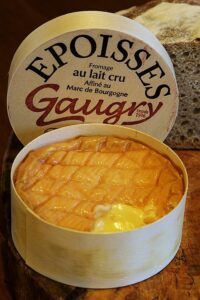
And with a bit of luck, we’ll be going to see Époisses cheese being made. and tasting ‘the best cheese in the world’.
*Jerold Frakes is a regular Chain Ganger, from Buffalo, New York. Believe it or not, he has actually made Époisses in Buffalo. On all cheese-related matters, if Jerold contradicts me, he’s right! I look forward to receiving a corrected ‘Even More Official’ Top 3.


